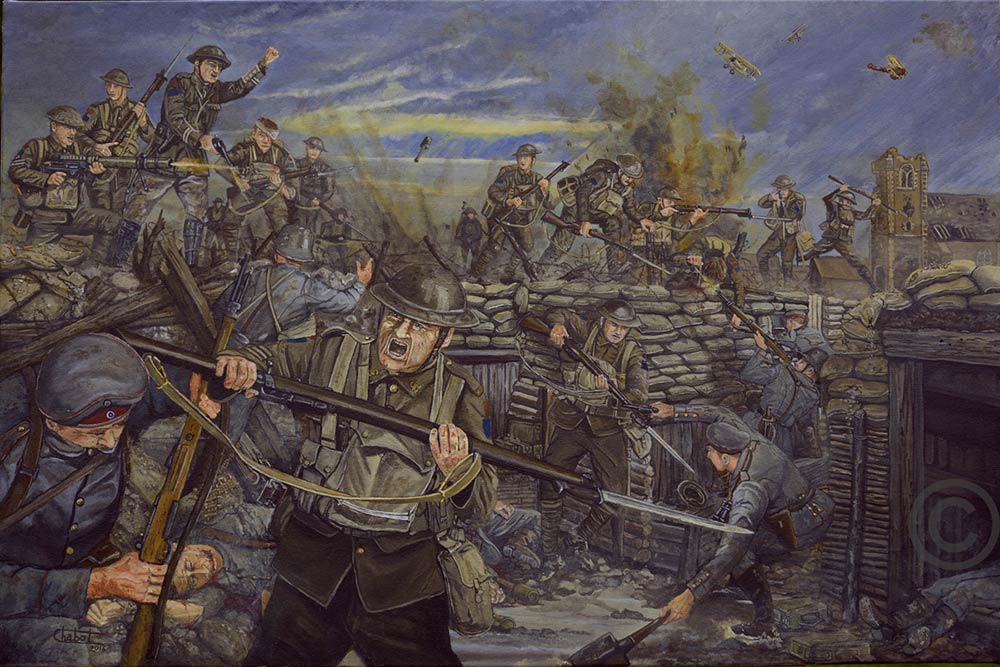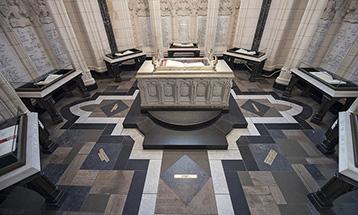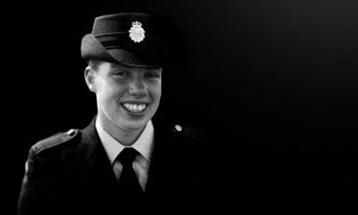The painting is huge: an expanse of canvas eight feet high and twenty-four wide, bearing images of the four operational commands of the Canadian Armed Forces (CAF) in action.
Its painter is retired imagery technician Sgt. (Ret.) Roger Chabot. Entitled “Mount Everest:” it’s the biggest painting he’s ever attempted but it’s far from the only project keeping him busy in this pandemic.
Bootsteps in acrylic paint
Roger Chabot started painting with acrylics in high school, and didn’t stop when he joined the Canadian Armed Forces. “I’ve left paintings behind all over the world,” he says: “Somalia, Croatia and across Canada.”
Born in Beloeil, Quebec on Montreal’s South Shore, Roger always wanted to be a soldier. He joined Air Cadets at age 13, and at 21, went to the Montreal Recruiting Centre to sign up with the Royal 22nd Regiment, the VanDoos. In the Airborne Regiment, he deployed to missions in Cyprus and Somalia. After rebadging to the Princess Patricia’s Canadian Light Infantry in 1994, he also served in Croatia and another tour to Kosovo in 1999.
Roger continued painting whenever, and wherever he could. “My passion is art and my interest is military,” he says.
A training accident in 1998 required six months of off-time. The silver lining was opportunity to paint. A lot. The result was a major advance in Roger’s skills and the quality of his images. Some of the paintings he completed during this time include 'Night Drop' and 'Airborne Sunrise'.
'Night Drop' by Roger Chabot
In 2000, Roger was posted to Canadian Forces Leadership and Recruit School (CFLRS), in St-Jean, as a Basic Training Instructor. Eventually he applied to train as an imagery technician—even though it meant a move down the ranks from sergeant to corporal.
Imagery techs work with photographs, video and any graphic elements that the CAF uses, for intelligence, communications and public relations. Imaging is also a critical element of combat operations.
As an Imagery Tech, Roger stationed in Cold Lake, Alberta for two years. Then, promoted to Master Corporal, he returned to Valcartier with Army News. He retired for the first time in 2005 after 20 years in the Army, he then moved to the Reserves and the Joint Imagery Centre in Ottawa, where he gave pre-deployment training in imagery.
“I missed going to Afghanistan,” he says. It’s a telling sentiment. He lost friends and some of those he trained in Canada’s longest military deployment.
Released, but still serving
Roger fully released from service in 2016, at the age of 55 and the rank of Sergeant. This gave him the time to focus on his family, including twin sons Samuel and William, who are now 11, and on painting.
“It was hard to make the transition from a completely structured life. You get used to a structured life, a regular pay cheque and you’re always with colleagues and friends. Even when you go to the mess for a meal by yourself, you know friends will be there.
“Painting brings me peace,” he says.
At the same time, Roger’s art keeps him connected to his military career and the military community.
In 2016, he finished a painting to commemorate the 100th anniversary of the Battle of Flers–Courcelette in France, which was commissioned by the Royal 22nd Regiment. In 2017, Roger donated “No Greater Love” to the Canadian War Museum in Ottawa on the centennial of the Battle of Vimy Ridge.
For the 50th anniversary of the Airborne Regiment in 2018, Roger completed “The Great Adventure,” unveiling it at a celebration in Edmonton where—much to Roger’s surprise—it was bought by an art collector.
'The Great Adventure' by Roger Chabot
“Painting is a way I can still contribute, where I can be in an environment where I feel valued,” Roger says.
Roger’s paintings now hang in the War Museum in Ottawa, La Citadelle in Québec City and the Military Museums of Calgary.
This is retirement?
In 2018, Roger travelled to Normandy to research for two paintings commemorating the 75th anniversary of D-Day. The Governor General unveiled the results in front of Canada House at Juno Beach: “The Liberators” and “Out of the Clouds”.
“It was an unplanned event until 48 hours before it happened,” Roger says.
Recently, Roger began making videos about his paintings, with support from Veterans organizations and the military community. His first, In Search of Pegasus, posted on YouTube and attracted the attention of more Veterans. Now, Roger has his own YouTube channel, where he posts his video series, Bravery in Arms.
'The Liberators' by Roger Chabot
'Out of the Clouds' by Roger Chabot
Support from his peers has allowed Roger to begin working on a large video project about Canadian “D-Day Dodgers”: he plans to take a team to Italy and follow in the footsteps of the 1st Canadian Corps during the Second World War through Sicily and the Italian peninsula.
“We have to tell that story,” Roger says. “We are all guardians of the memory.”
And in the midst of the pandemic, Roger embarked on his biggest project yet, his “Mount Everest:” a mural 24 by 8 feet, comprising eight canvasses, to hang in the Hall of Honour at the new Department of National Defence headquarters in Ottawa. Painted on canvas, the eight panels will depict the four operational commands of the Canadian military in their current equipment, and will be supplemented by large video displays.
From painting, to events, to video projects and series, Roger Chabot’s life and work after service keeps him connected to the military community in Canada and internationally.
“It’s like he never retired,” says his wife, Isabel Paré.
“We are all guardians of memory, when we engage in activities of remembrance,” Roger says. “If I can educate Canadians about our history, I will have preserved memory.”
Note: The Respect Campaign helped support Roger Chabot’s remembrance projects. The organization has received financial support from the Veteran and Family Well-being Fund.








